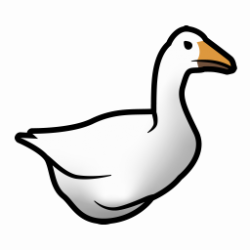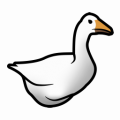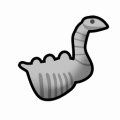Goose
Goose
A domesticated bird kept by humans as poultry for it's eggs and meat. Lays eggs very often, however they take a long time to hatch.
Base Stats
- Type
- Animal
- Flammability
- 70%
Pawn Stats
- Combat Power
- 35
- Move Speed
- 2.3 c/s
- Health Scale
- 40% HP
- Body Size
- 0.6
- Mass - Baby
- 3.6 kg
- Mass - Juvenile
- 18 kg
- Mass - Adult
- 36 kg
- Carrying Capacity
- 45
- Filth Rate
- 6
- Hunger Rate
- 0.45 Nutrition/Day
- Diet
- herbivorous
- Life Expectancy
- 8 years
- Manhunter Chance
- 0%
- Manhunter Chance (Taming)
- 0%
- Trainable Intelligence
- None
- Wildness
- 60%
- Minimum Handling Skill
- 5
- Roam Interval
- 7 days
- Mate Interval
- 8 hours
- Maturity Age
- 0.2 years (12 days)
- Juvenile Age
- 0.12 years (7.2 days)
- Comfortable Temp Range
- -10 °C – 40 °C (14 °F – 104 °F)
Production
- Meat Yield
 84 bird meat
84 bird meat- Leather Yield
 26 birdskin
26 birdskin- Eggs Per Clutch
- 1 to 1
- Egg Laying Interval
- 2 days
- Can Lay Unfertilized Eggs
- true
Melee Combat
- Attack 1
- Feet
3 dmg (Scratch)
4 % AP
1.5 second cooldown - Attack 2
- Beak
5.6 dmg (Bite)
8 % AP
2 second cooldown - Attack 3
- Head
2 dmg (Blunt)
3 % AP
1.5 second cooldown
0.2 chance factor - Average DPS
- 1.6368
- tradeTags
- AnimalFarm, AnimalCommon
A Goose is a domesticated, medium-sized waterfowl, known for its large eggs and belligerent nature. Like all farm animals geese cannot be found in the wild, and must be purchased from traders.
Summary[edit]
Geese are pen animals. Once tamed, pen animals cannot and do not need to be trained any further. But if left outside of a pen or caravan hitching spot, pen animals will eventually roam outside your colony. Making a caravan is not required to tie animals to a caravan hitching spot.
A female goose produces 1 eggs every 2 days. Geese can lay both unfertilized and fertilized eggs, depending on if it has mated with a male goose.
Analysis[edit]
Eggs[edit]
An adult goose consumes 0.45 nutrition per day, and produces 0.25 nutrition of eggs each day, resulting in a nutrition efficiency of 55.8% when unfertilized eggs are eaten.
When eating eggs raw, geese are inferior to chickens. Chickens produce 2 half-size chicken eggs for 1 goose egg. As 2 hens consume less food than 1 goose, chickens are a better egg-layer. When eggs are allowed to hatch and are slaughtered as babies, chickens become even better for meat.
Note that geese produce birdskin if slaughtered as goslings, but chickens don't produce any leather.
Meat[edit]
When slaughtered, a goose yields 17 bird meat as a gosling; 42 as a juvenile; or 84 as an adult.
By slaughtering the geese rather than eating the unhatched fertilized egg, more nutrition is gained (0.85 rather than 0.5). When new-born goslings are slaughtered, an always-fertilized female goose produces 0.43 nutrition per day, resulting in a nutrition efficiency of 94.9% for the female goose alone. A 4:1 female:male ratio reaches an optimal fertilization rate. With this ratio of geese, you reach a nutrition efficiency of 75.9%.
A goose takes 7.2 days to become a juvenile, and a total of 12 days to reach adulthood. As a gosling grows into adulthood it will consume 2.9 nutrition in total, and will yield 3.35 more nutrition when slaughtered than it would as a baby. When slaughtered as adults, geese have a true nutrition efficiency of 104.4% (with a 4:1 female:male ratio).
Leather[edit]
In addition to meat, a goose yields 6 leather as a gosling; 18 as a juvenile; or 26 as an adult.
Birdskin isn't a particularly great leather, but it can be sold for some cash if you happen to be using geese in your colony.
Training[edit]
This animal can be trained as follows:
| Guard: | |
|---|---|
| Attack: | |
| Rescue: | |
| Haul: | |
*As of version 1.1.2610, all animals can be tamed. The percentage of likelihood of success depends on factors such as the Animals Wildness Percentage, Pawn Handling Skill, and others. More information can be found on the animals page.
Health[edit]
| Part Name | Health | Quantity | Coverage[1] | Target Chance[2] | Subpart of | Internal | Capacity[3] | Effect if Destroyed/Removed |
|---|---|---|---|---|---|---|---|---|
| Body | 16 | 1 | 100% | 19% | N/A[4] | - | Death | |
| Tail | 4 | 1 | 10% | 10% | Body | - | - | |
| Spine | 10 | 1 | 5% | 5% | Body | Moving |
−100% Moving[5] | |
| Stomach | 8 | 1 | 4% | 4% | Body | Digestion |
−50% Digestion | |
| Heart | 6 | 1 | 3% | 3% | Body | Blood Pumping |
Death | |
| Lung | 6 | 2 | 4% | 4% | Body | Breathing |
−50% Breathing. Death if both lost. | |
| Kidney | 6 | 2 | 3% | 3% | Body | Blood Filtration | −50% Blood Filtration. Death if both lost. | |
| Liver | 8 | 1 | 5% | 5% | Body | Digestion |
−50% Digestion | |
| Neck | 10 | 1 | 20% | 5% | Body | Eating Talking Breathing |
Death | |
| Head | 10 | 1 | 75% | 3.1% | Neck | - | Death | |
| Skull | 10 | 1 | 30% | 1.8% | Head | - | Cannot be destroyed. Increasing Pain based on damage. | |
| Brain | 4 | 1 | 60% | 2.7% | Skull | Consciousness |
Death Damage always results in scarring. | |
| Eye | 4 | 2 | 12% | 1.8% | Head | Sight |
−25% Sight. −100% if both lost. Damage always results in scarring. 0% Hit Chance against Blunt damage. | |
| Beak | 8 | 1 | 25% | 3.8% | Head | Eating Talking Manipulation |
−100% Manipulation −90% Eating[6] | |
| Leg | 12 | 2 | 10% | 5% | Body | Moving |
−50% Moving. −100% if both lost. | |
| Foot | 10 | 2 | 50% | 5% | Leg | Moving |
−50% Moving. −100% if both lost. |
- ↑ Coverage determines the chance to hit this body part. It refers to the percentage of the super-part that this part covers, before its own sub-parts claim their own percentage. For example, if the base coverage of the super-part is 100%, and the coverage of the part is 20%, 20% of hits would hit the part, and 80% the super-part. If the part had its own sub-part with 50% coverage, the chances would be 10% sub-part, 10% part, 80% super part.
- ↑ Target Chance is the actual chance for each part to be be selected as the target when each part's coverage has been taken into account(I.E. Neck covers 7.5% of Torso but Head covers 80% of Neck so it actually has only a 1.5% chance to be selected). This is not pure hit chance, as different damage types propagate damage in different ways. See that page for details.
- ↑ Note that capacities can affect other capacities in turn. Only the primary effect is listed. See specific pages for details.
- ↑ This is the part that everything else connects to to be considered 'connected'.
- ↑ If Moving drops below 16% a pawn cannot move.
- ↑ Note that eating won't go below 10%.
Gallery[edit]
Version history[edit]
- 1.1.0 - Added as part of the integration of the Vanilla Animals Expanded - Livestock mod into the basegame.




